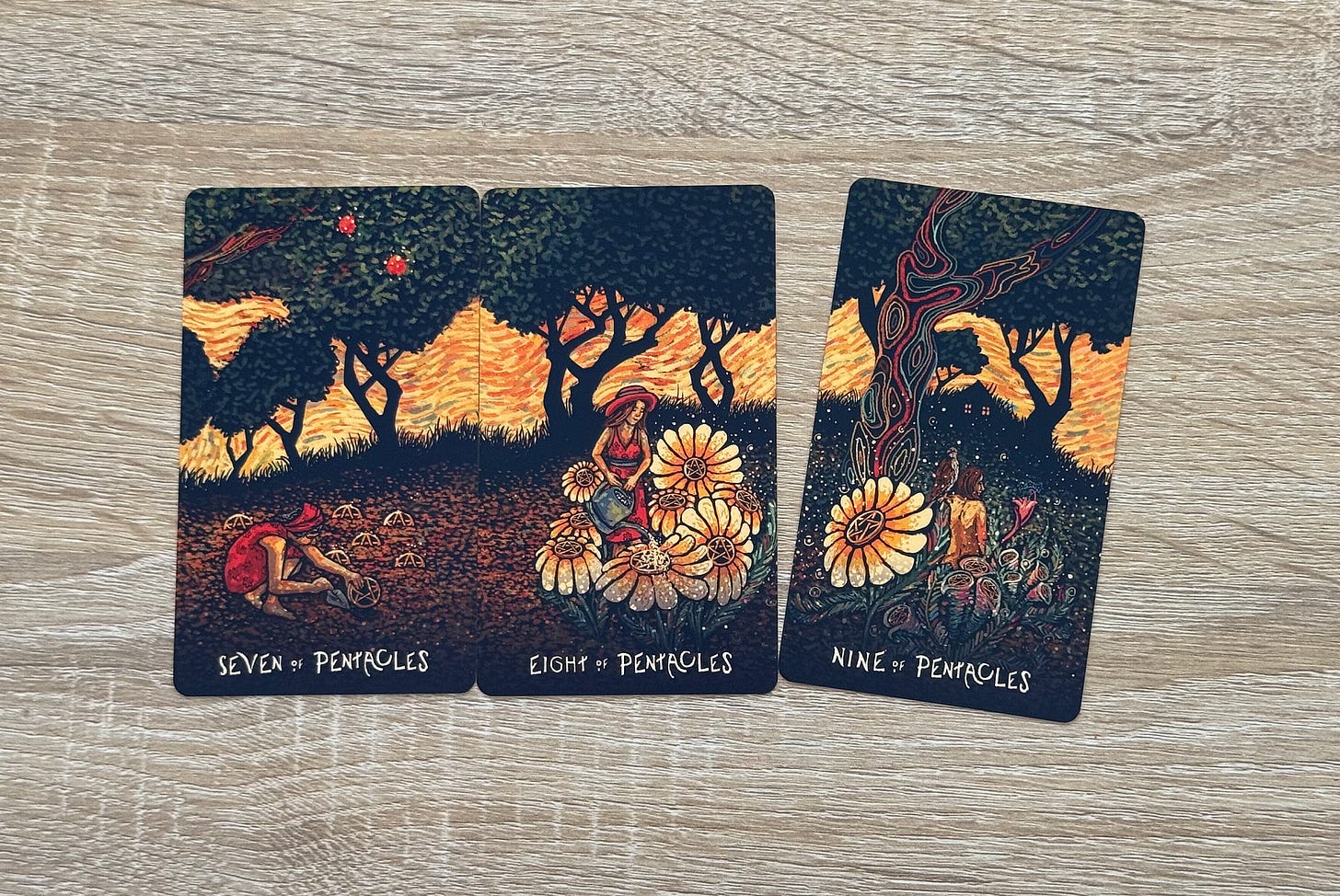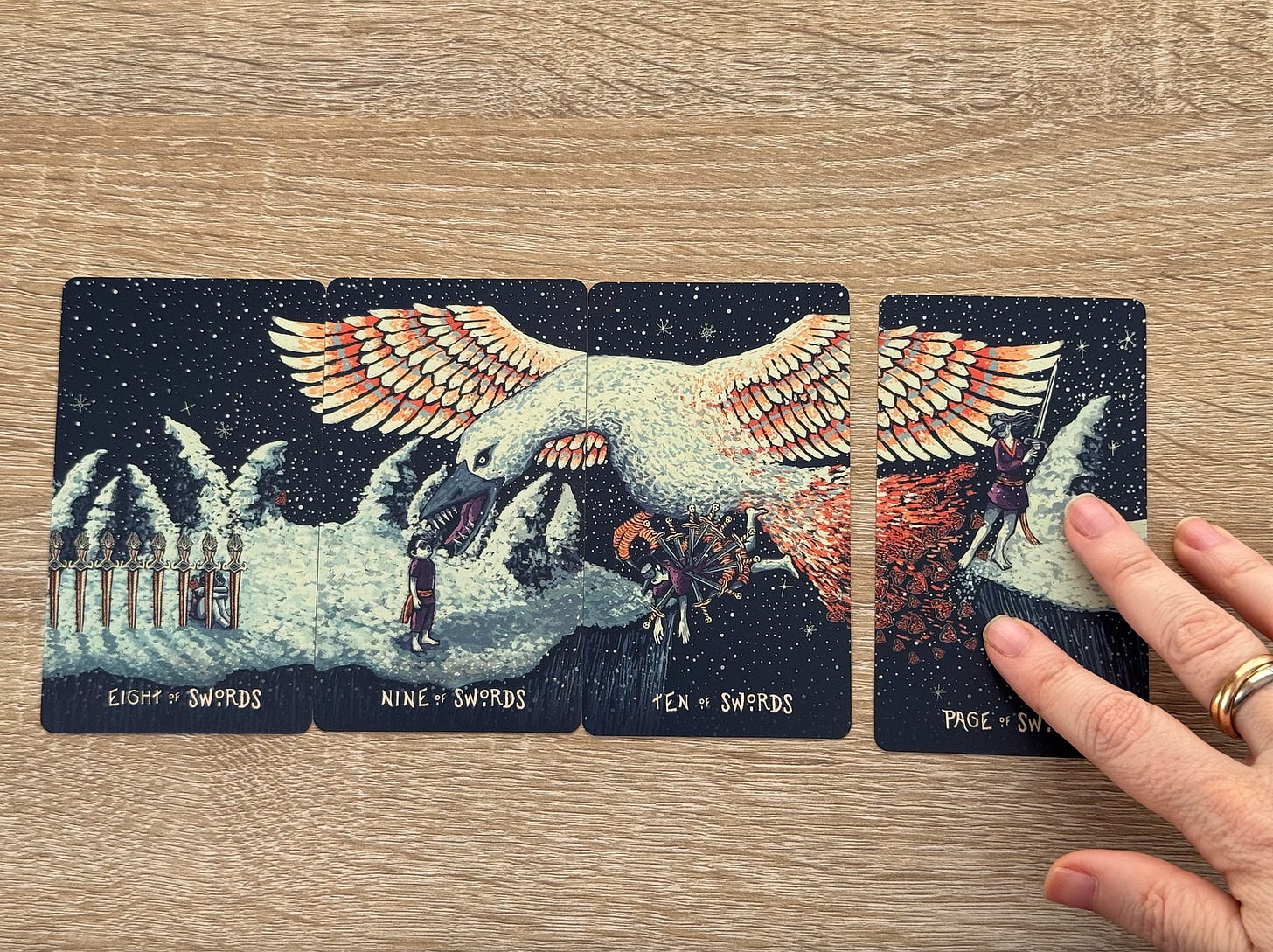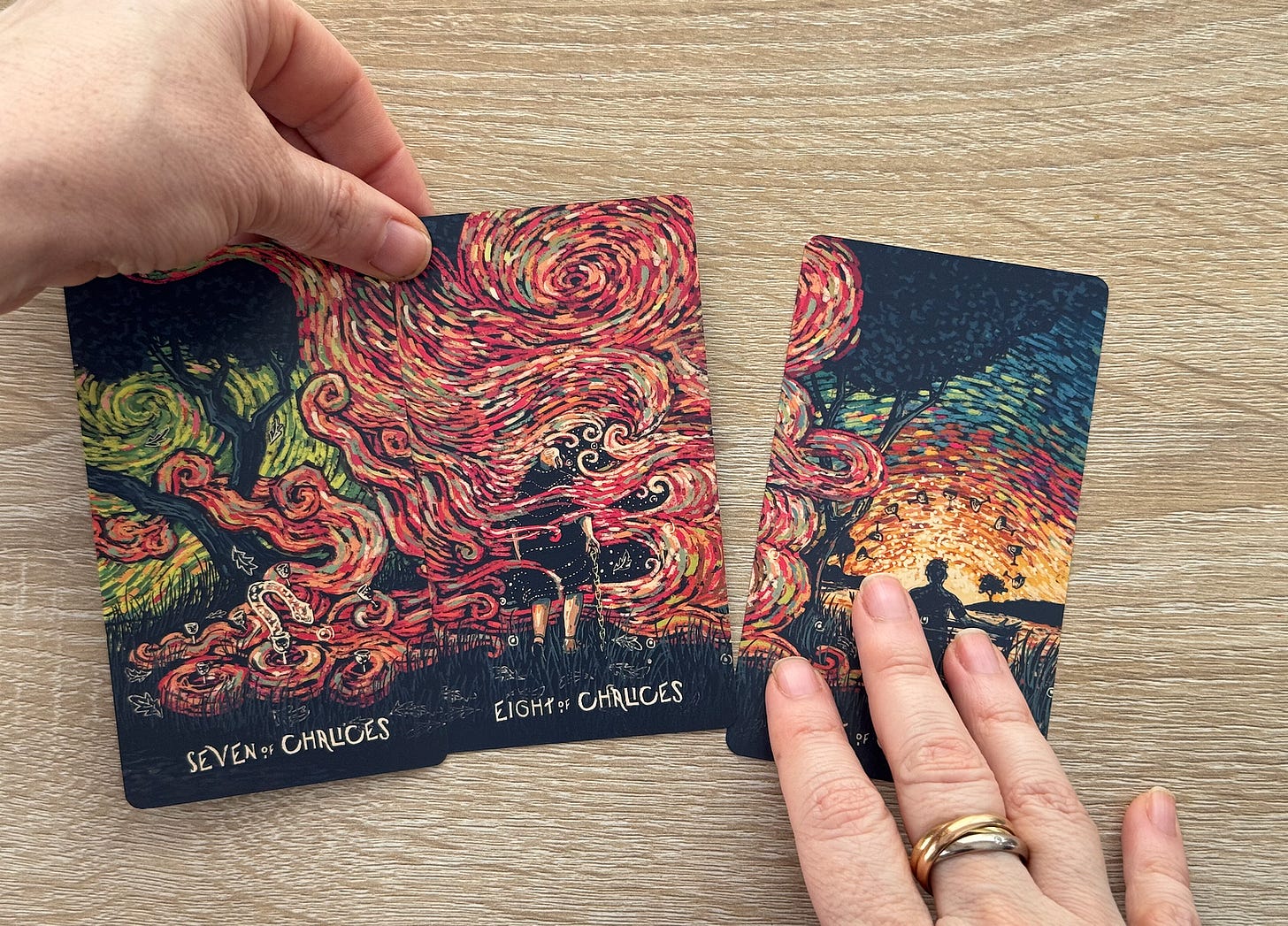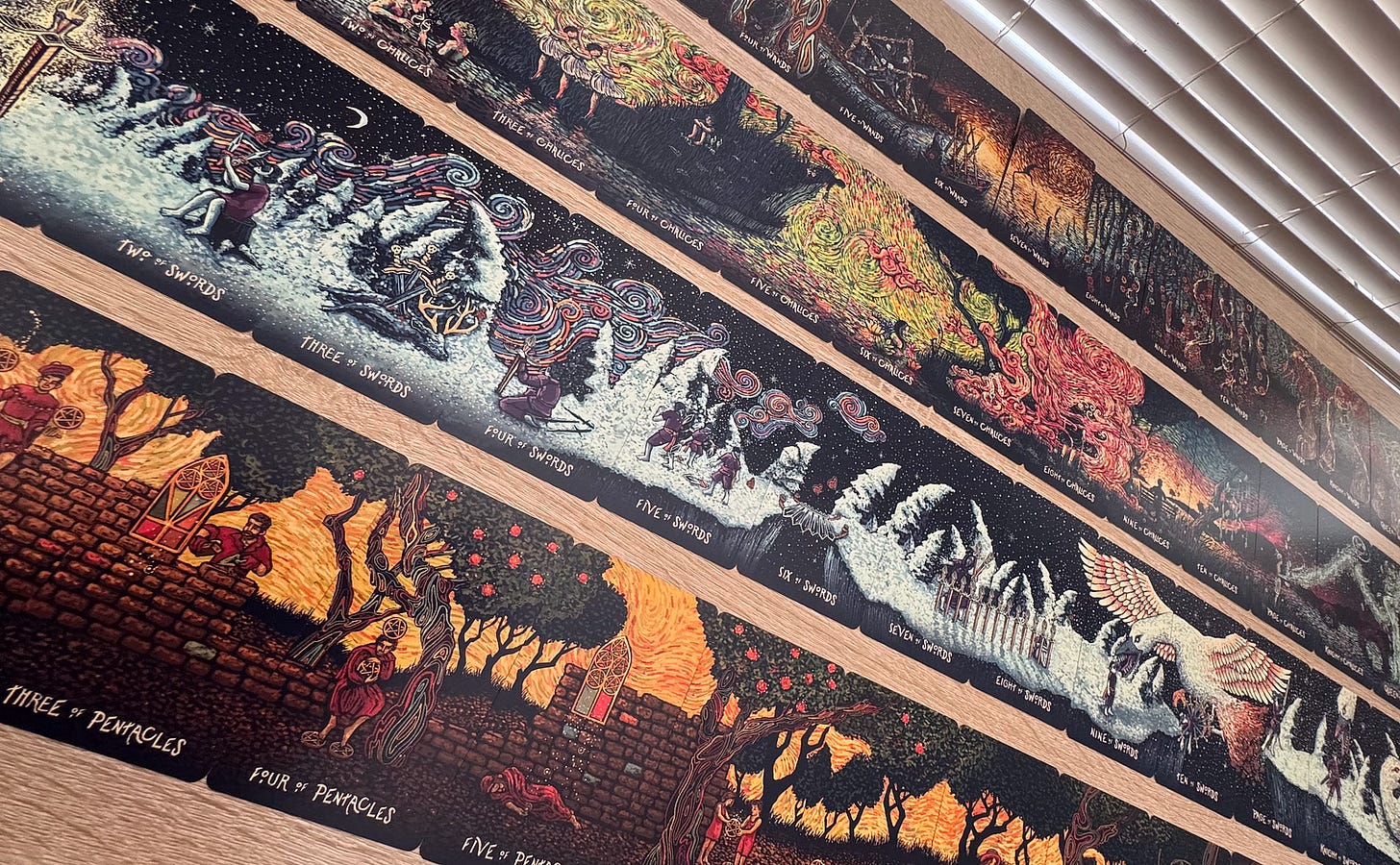When I opened the Prisma Visions Tarot deck by James R. Eads, I wasn’t looking for brand strategy insights. I just wanted a little spark of inspiration. But as I laid the cards down, one by one, I found myself in awe. Each image flowed into the next, and each card was part of something bigger. And slowly, something clicked.
This isn’t just a deck. It’s a panorama. Each suit, Cups, Wands, Swords, and Pentacles , tells its own story. When you line up all 14 cards in a suit, they form a continuous, unfolding visual narrative. Four different journeys. Four different arcs.
And I couldn’t help but think: this is branding.
Not just as a metaphor. As a map.
Because branding isn’t about a logo here, a headline there, a website, a LinkedIn post. It’s how all those pieces hold hands. It’s the story they tell together. It’s the feeling that builds when everything is connected.
That’s the real magic.
Tarot, for the uninitiated
If tarot feels a little far from your world, stay with me. I promise this will make sense.
A tarot deck is made of 78 cards: each one a symbolic snapshot of a human experience. Some people use them for spiritual connection. Others, love them as a language of images that can spark an inner message needed at the moment. Each card tells a fragment of a bigger story. Insights emerge, often directly tied to the question or intention you began with.
Even if you’re the most practical person in the room, you can appreciate this: storytelling through images changes how we see things.
And sometimes, it changes how we see our own work.
Enter James R. Eads and Prisma Visions
James R. Eads is a Los Angeles-based artist whose work lives somewhere between surreal dreamscapes and emotional reality. His Prisma Visions Tarot is loved not just for its vivid artwork, but for something few decks attempt : each of its four suits connects visually, card to card, to form one long continuous image.
Laid out in order, they create panoramic illustrations. Each card is rich on its own, but the full picture only reveals itself when you step back.
I know that feeling. It’s the same one I get when I work with a brand that finally starts to feel like itself.
Branding is a Panorama
Too often, we build brands in bits and pieces.
We get obsessed with the homepage. We fuss over Instagram. We lose days to choosing the “right” shade of green. And while those details matter, zooming in too far can blur the big picture.
We treat branding like a to-do list: logo? Check. Pitch deck? Check. Tagline? Check. But that’s like picking a card from a deck and thinking you know the whole story.
Your brand isn’t one thing. It’s the relationship between things.
It’s the way your packaging echoes your mission. The way your website feels like your values. The way your DMs sound like your About page.
One touchpoint at a time, a picture starts to take shape. And when you’re intentional, when you build with the whole in mind, that picture becomes clear, beautiful, and aligned.
That’s what this tarot deck reminded me. When you step back, you see the story.
Brand sequencing is strategy
Here’s something I see all the time: amazing brands with all the right pieces, but no arc.
In tarot, the order of the cards matters. The same card can mean something entirely different depending on where it sits in the story. And in branding is the same thing.
Let’s say someone first finds you through a post on LinkedIn. That’s your Ace: the spark. Then they click to your site (hello, Two, Three, Four of the journey). Maybe they join your list, grab your lead magnet, follow your stories. They’re moving deeper into your world.
Every step they take is a chance to say, “Yes, this is who we are.”
If each step is disjointed, they won’t feel invited in. But if it flows, if your sequence builds trust and clarity, you’re not just showing up. You’re guiding them.
Great brands don’t rely on lucky moments. They build momentum. Sequentially.
Cohesion builds trust
One of the things I love about the Prisma Visions deck is how each card holds its own, yet clearly belongs to something bigger. The artwork shifts subtly across the sequence, but the energy is always aligned. Nothing feels random.
This is what good branding does.
If your social media says one thing, your sales deck another, and your packaging something else entirely, people feel that disconnect. Even if they don’t consciously notice it, they feel it.
And what people feel is what they trust.
Cohesion isn’t about being repetitive. It’s about being rooted. When everything flows from the same essence, your brand becomes recognizable. Familiar. Safe.
And no, that doesn’t mean you can’t evolve. You absolutely should. But when your evolution feels like the next chapter , instead of a whole new book, people come with you.
The long game
Decks like Prisma Visions weren’t made overnight. You can feel the depth and intention in every card. There’s a rhythm to the way the story unfolds. A throughline.
That’s the energy I want you to bring to your brand.
It’s tempting to change course every time engagement dips or something shiny pops up in your feed. But strong brands don’t pivot out of panic, they adapt with purpose.
Trends come and go. Your audience wants to know you have a center, a clear sense of who you are and why you do what you do.
Every design choice, every headline, every photo - they all belong to the same ecosystem. The same story.
Zooming out
Here’s a little exercise I love:
Lay out your brand like you’d lay out a deck.
Pull up your homepage, your Instagram grid, your email footer, your onboarding sequence, your about page, your podcast cover, your packaging… whatever you’ve got.
Then take a breath and look at it all together.
What do you see?
Does it feel aligned? Does it feel alive? Do the pieces build on each other?
Or do some feel like strangers to each other?
Sometimes we’re too close to see what’s out of step. That’s why zooming out matters. It reveals not just what’s missing, but what’s been waiting to come through.
What’s in your panorama?
Branding is more than color palettes and clever lines. It’s about creating a world people can step into and trust.
James R. Eads’ tarot deck reminded me of what I already know: when each part is built with the whole in mind, everything feels more powerful. And more true.
So here’s your invitation:
Lay it all out. Look at the big picture. What story are you telling, not in pieces, but in panorama?
What still needs to be added, refined, or reimagined?
And what becomes possible when every part of your brand points in the same direction?
That’s where your next move lives.






Oh, i love this sense of a panoroma opening up. "Your brand isn’t one thing. It’s the relationship between things." I'm not trying to create a brand, but I'll read this post again for its insights. :)